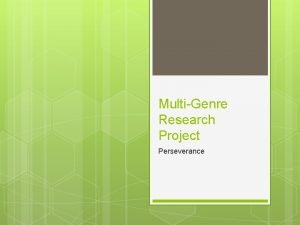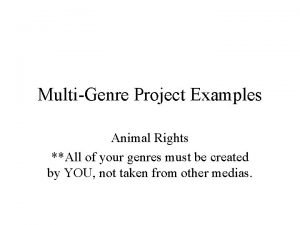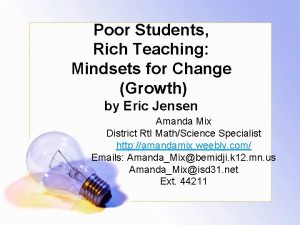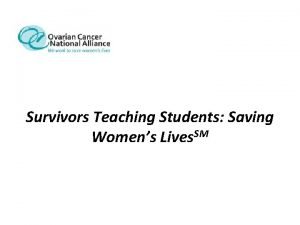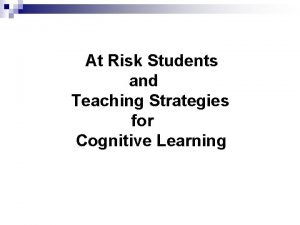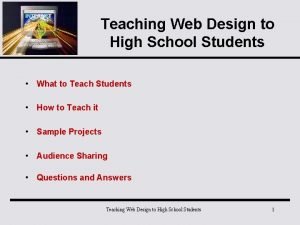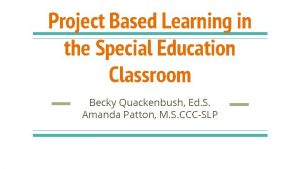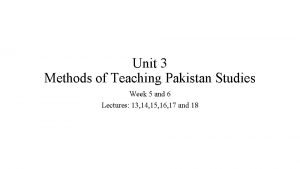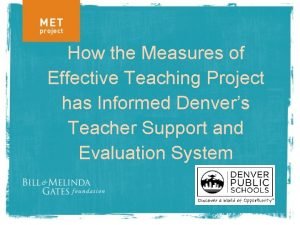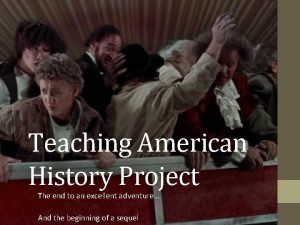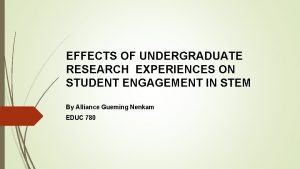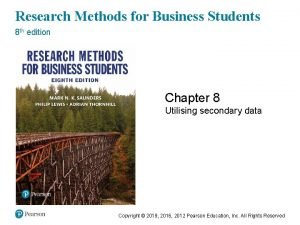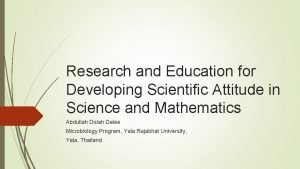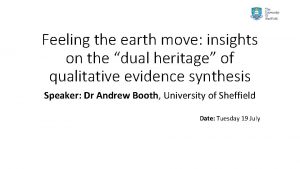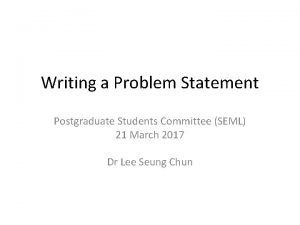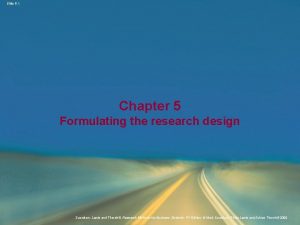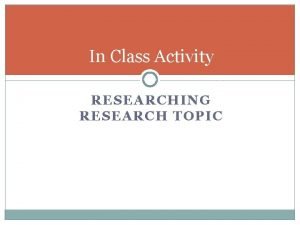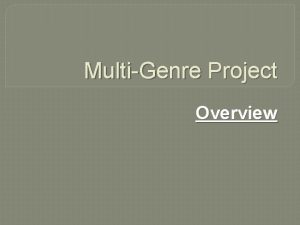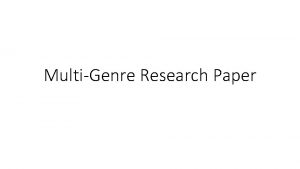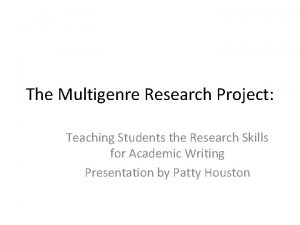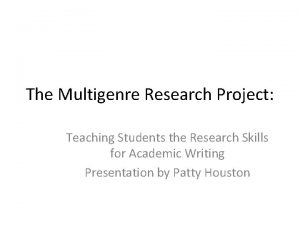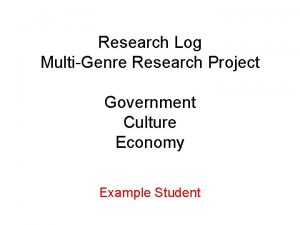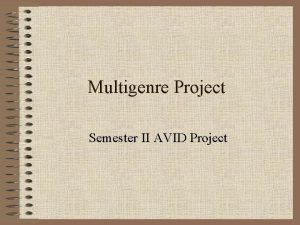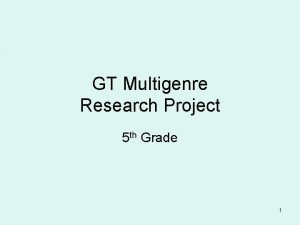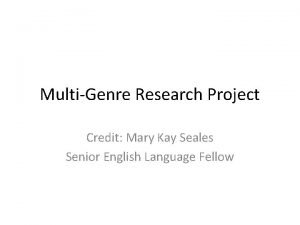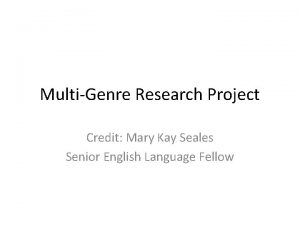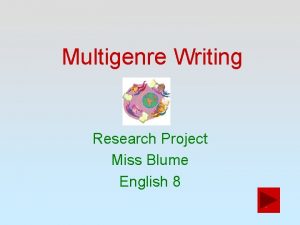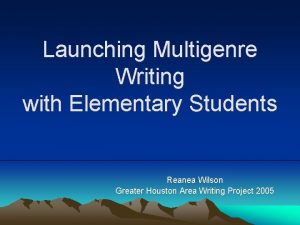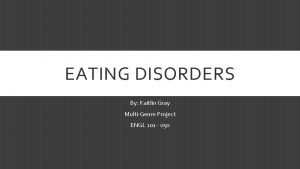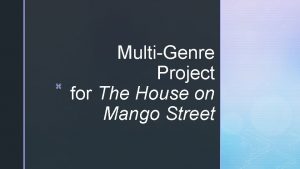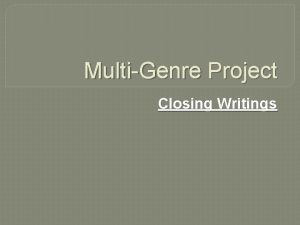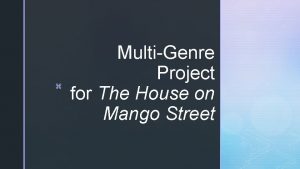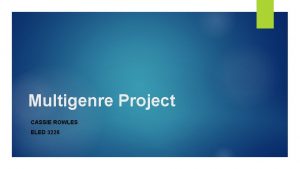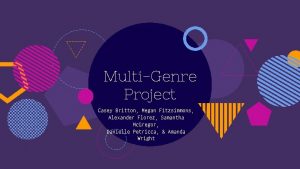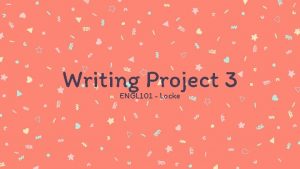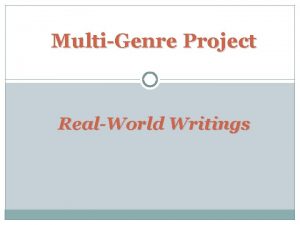The Multigenre Research Project Teaching Students the Research






















- Slides: 22

The Multigenre Research Project: Teaching Students the Research Skills for Academic Writing Presentation by Patty Houston

Introduction Often teachers are dissatisfied with standard papers or they simply want passion restored to students’ voices. I am one of those teachers. In my search for restoration I did two things: v. Studied my university’s goals for its English composition students. v. Researched genre theory.

My Findings Goals many comp students have difficulty with: v Recognizing that different writing situations require different strategies. v Recognizing that texts are in conversation with other texts. v Understanding and demonstrating their ethical responsibility to explore multiple perspectives on a topic.

Genre Theory Richard Johnson-Sheehan and Charles Paine (Writing Today 2010) maintain: Genres reflect the things people do, and they are always evolving because human activities change over time to suit new social situations and new challenges…More importantly, though, they reflect how people act, react, and interact in these situations. Genres are meeting places and meaning places (2 – 3). The authors’ description of genres as always evolving and as meeting and meaning places makes the study of genre especially relevant to the goals of composition that include a multigenre research project. Such a project teaches students the research skills they need for academic writing and helps them become more flexible writers by developing an awareness of how genre works.

The Multigenre Research Paper As Tom Romano explains in his book Blending Genre, Altering Style: Writing Multigenre Papers: A multigenre paper arises from research, experience, and imagination. It is not an uninterrupted, expository monolog nor a seamless narrative of poems. A multigenre paper is composed of many genres and subgenres, each piece is selfcontained, making a point of its own, yet connected by theme or topic and sometimes by language, images, and content. In addition to many genres, a multigenre paper may also contain many voices. The trick is to make such a paper stick together (x – xi).

Ready to Take the Leap After discovering the multigenre paper and reviewing many examples, I was ready to try this assignment with students. I am learning that students only begin to appreciate the style, versatility, and possibilities of such a project after they create their first genre, followed by the next step of envisioning additional genres that might “grow out of” that first one and extend its argument.

How to begin? By exploring genre. v Post a “Brief List of Genres” that contains 50+ types of writing. v Post a selection of readings. Students sign up in pairs to present a reading to the class. v As part of the presentation to the class, students must: 1. Share a second genre of their choosing that relates to the topic, issue, event…in the reading they signed up for. 2. Facilitate a discussion of content followed by a comparison of the two genres, examining them for intended audience, how the writer wants the audience to act/feel, writer’s purpose, organizational features. . . 3. Suggest generic recasts for each genre that is shared.

To Clarify: An Example v Two students present the reading “Stooping to Conquer: Why Candidates Need to Make Fun of Themselves” (New Yorker, 4 -’ 04). v The students find also share the October 20, 2016 CNN transcript “Clinton, Trump – Best Moments from Al Smith Dinner. ” v After discussing the content of both pieces and comparing the two for intended audience, etc. , the students suggest generic recasts of the ideas in the two pieces. Recast examples: a review of the Sept. 1968 “Laugh-In” episode in which Richard Nixon appeared and said, “Sock it to me!”; or a letter to the editor in response to Howard Dean’s “scream” followed by his appearance on the “Late Show with David Letterman”; or a political cartoon / comic strip showing Obama making jokes about himself.

Next Step v. After all presentations are finished, students choose one issue, topic, or event of the many reviewed in class, then they recast that issue in a different genre. v. Additionally, students write a paper to accompany the recast in which they discuss their intended audience, how they want their audience to act/feel, their focus, aim, organization, document design, etc.

Introduce the Multigenre Paper: v First, students examine 3 well-known texts that show “multigenres at work”: v The Collected Works of Billy the Kid (1970) by Michael Ondaatje (author of The English Patient). This imaginative story of the famous desperado is told in eyewitness accounts, tall tales, facts, and photographs. v Nothing But the Truth: A Documentary Novel (1992) by Avi (a Newbery Award winning author). This is the story of a boy who is suspended from school for humming the US National Anthem and is told through diary entries, personal letters, school memos, and transcripts of dialogues. v Tears of a Tiger (1994) by Sharon Draper (a Cincinnati author and a former CPS teacher). This is the story of a boy who is responsible for his best friend’s death and is told through newspaper articles, phone calls, police statements, homework assignments, letters to friends, poetry, prayers…

3 Texts: Important points to make v The subjectivity of truth: individual statements may be true but separately they may not give an accurate picture of an event. v The subjectivity of truth is a key concept we want students to understand, that is, the ethical responsibility of the research writer to explore multiple perspectives on a topic. v For example: The Collected Works of Billy the Kid is a portrait of the man behind the legend. He is a lover as well as a killer, shy and gentle as he is vicious. Ondaatje writes, “I was fascinated by the mind and imagination and motive of someone like Billy, and I wanted to have Billy talk from the core of his story. There was a need to create a world where Billy could breathe and act in total freedom” (Book jacket).

Once students see the possibilities: v. Review the Multigenre Research Project (MGP) – the assignment sheet. v Like Ondaatje, Avi, and Draper, students’ projects will present multiple, even conflicting perspectives on a topic or event in order to provide a rich context for an audience. v Emphasize that their MGP should reflect a coherent organization to not only lead readers through the project, but to help readers understand its focus and purpose.

8 Required Documents in the MGP v Introduction – guides readers, helping them understand the issue being addressed, offering insight about why selected genres were chosen, why this topic is important, and how the documents should be “read. ” Intros can be written as a letter to the reader, a magazine article, an editorial… v Table of Contents – gives an overview of and title to each document. v 5 documents of different genres, for example: an academic research essay, editorial, feature story, brochure, short fiction, chart, script, etc. v Works cited page v Together these documents must offer a sustained argument about a chosen issue. v MGPs are “packaged” as a scrapbook, a photo album, a patient file, an employee handbook, a newspaper, a magazine, etc.

Why 5 or more different genres? v. By creating documents in different genres, students learn to write for multiple audiences, multiple purposes, and multiple forums. v. Students are able to transfer knowledge from one context to another because genre knowledge helps them analyze and adapt to various writing situations. v. Students become more flexible, confident writers.

Striking a Balance v I require students to begin with a research paper that contains direct and indirect quotes and in-text citations. v Next, they might create a brochure that uses their research sources, a chart or other visual, a story that draws from the information gathered, a quiz based on researched sources. . . v My goal is for students’ MGPs to help an audience understand many different perspectives on their topic. v While some genres are more time-intensive than others, the 5 together should show students’ knowledge, creativity, and ability to persuade their audience toward their central claim. v Finally, the MGP must conclude with a works cited page.

3 Sample MGPs from past academic years Conference for HIV/AIDS Awareness Table of Contents Introduction (A welcome letter to conference attendees) Conference Itinerary Madeline’s Ribbon Personal Stories Educational Pamphlet Educational HAART Therapy Flipbook

The Harmful Effects of Child Pageantry: An Informational Booklet for Mothers Table of Contents Introduction – Letter to Mothers Miniature Drag Queens - Magazine Article Psychiatric Case Studies of Pageant Queens Cost Analysis of a Typical Pageant Miss Teen South Carolina, Nicole Upton – Newspaper Editorial Save Your Child Before It’s Too Late – a Brochure

Why Classical Music Matters A Cincinnati Arts Sampler for Parents Table of Contents Positive Effects of Classical Music on the Brain and Body A research paper on the positive benefits of listening to classical music. Listen Up! An editorial featured in the Cincinnati Enquirer that is pro-music. Classical Music 101 A playlist of basic classical pieces designed to engage, but not overwhelm, new listeners. Did you know? Brief historical facts about famous composers and musical pieces. Suggestions for Your First Trip to the Symphony These tips will make you enjoy going to the orchestra so much, you’ll never stop going!

Counterarguments and Accommodations v. Students do not learn to carry on a sustained written discussion of a topic Responses: 1. Students include in their MGP a research paper or the equivalent. 2. Consider that it’s likely students have written many research papers and embrace the freedom of choosing among countless genres. 3. Including discussions of purpose, audience, and power are important parts of every students’ development as a writer and thinker.

C. and A. continued v. Students do not develop the research skills needed for academic writing. Response: Students do develop the research skills needed for academic writing. For example: Have students conduct interviews and turn in a minimum number of print and Internet sources with an annotated bibliography.

Concluding Remarks: On Assessment v Claim / Structure: Is the writer’s research evident in each document? v Focus: Does each piece have a main point? v Audience: Has the writer developed his/her information to sway a particular audience? v Organization: Where does each document “fit” within the larger structure of the MGP? AND: How does each document further the writer’s central persuasive claim? v Style: Is the tone of each genre appropriate for the designated audience?

Works Cited Avi. Nothing But The Truth: A Documentary Novel. New York: Orchard Books, 1991. Print. Draper, Sharon M. Tears of a Tiger. New York: Anthem Books, 1994. Print. Johnson-Sheehan, Richard, and Charles Paine. Writing Today. Boston: Longman, 2010. Print. Kolbert, Elizabeth. “Stooping to Conquer: Why Candidates Need to Make Fun of Themselves. ” The New Yorker, April 19 and 26, 2004, pp 116 – 122. Print. Ondaatje, Michael. The Collected Works of Billy the Kid. New York: W. W. Norton and Company, Inc. , 1970. Print. Romano, Tom. Blending Genre, Altering Style: Writing Multigenre Papers. Portsmouth, NH: Boynton / Cook Publishers, Inc. , 2000. Print.
 Multi genre topics
Multi genre topics Multi genre project topics
Multi genre project topics Dominican professors were hostile to rizal
Dominican professors were hostile to rizal Relational mindset
Relational mindset Survivors teaching students
Survivors teaching students Teaching at risk students
Teaching at risk students Web design projects for high school students
Web design projects for high school students Meaning of micro teaching
Meaning of micro teaching Project based learning for special education students
Project based learning for special education students Teachingenglish org uk
Teachingenglish org uk Unit method for teaching pakistan studies
Unit method for teaching pakistan studies Measures of effective teaching project
Measures of effective teaching project Teaching american history project
Teaching american history project Importance of research in students
Importance of research in students Research methods for business students 2019
Research methods for business students 2019 Benefits of research to students
Benefits of research to students Qualitative research examples for students
Qualitative research examples for students Problem statement in research proposal
Problem statement in research proposal What is objective in research
What is objective in research What is problem statement
What is problem statement Research methods for business students chapter 5
Research methods for business students chapter 5 Topic down
Topic down Research problem example for students
Research problem example for students
